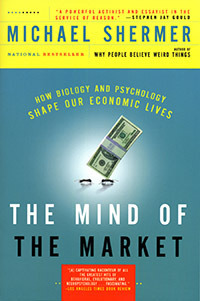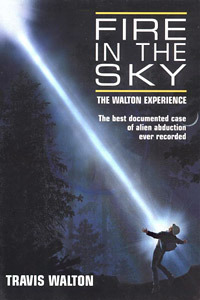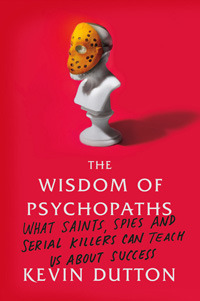Michael Shermer's Blog, page 12
October 1, 2012
Politically Irrational
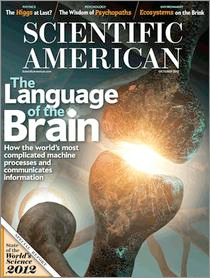
With the 2012 presidential election looming on the horizon in November, consider these two crucial questions: Who looks more competent, Barack Obama or Mitt Romney? Who has the deepest and most resonant voice? Maybe your answer is, “Who cares? I vote for candidates based on their policies and positions, not on how they look and sound!” If so, that very likely is your rational brain justifying an earlier choice that your emotional brain made based on these seemingly shallow criteria.
Before the election, I urge you to read Leonard Mlodinow’s new book, Subliminal: How Your Unconscious Mind Rules Your Behavior (Pantheon). You will gain insights such as that higherpitched voices are judged by subjects as more nervous and less truthful and empathetic than speakers with lower-pitched voices, and that speaking a little faster and louder and with fewer pauses and greater variation in volume leads people to judge someone to be energetic, intelligent and knowledgeable. Looks matter even more. One study presented subjects with campaign flyers featuring black-and-white photographs of models posing as Democrats or Republicans in fictional congressional races; half looked able and competent, whereas the other half did not, as rated by volunteers before the experiment. The flyers included the candidate’s name, party a!liation, education, occupation, political experience and three position statements. To control for party preference, half the subjects were shown the more suitablelooking candidate as a Democrat, and the other half saw him as a Republican. Results: 59 percent of the vote went to the candidate with the more capable appearance regardless of other qualifications. A similar study in a mock election resulted in a 15-percentage- point advantage for the more authoritative-looking politician.
To test these e”ects in real elections, Princeton University psychologist Alexander Todorov and his colleagues had volunteers rate for “competence” black-and-white head shots of all the candidates in 600 contests for the U.S. House of Representatives and 95 races for the Senate from 2000, 2002 and 2004. Results: candidates rated as more competent won 67 percent of the House races and 72 percent of the Senate ones. In a followup study published in 2007 the psychologists conducted the face-evaluation process before the 2006 elections, predicting the winners in 72 percent of Senate runs and 69 percent of gubernatorial competitions based on the candidates’ appearances alone.
These data—and others—confirm what was perceived the night of September 26, 1960, during the first televised presidential debate between John F. Kennedy and Richard M. Nixon. Well-rested, and tan from campaigning in California, Kennedy was radiant, like an “athlete come to receive his wreath of laurel,” journalist Howard K. Smith noted. In contrast, Nixon had been campaigning right up to the debate and had been hospitalized for a knee infection that had left him with a 102-degree fever and looking pale and haggard, worsened by his notoriously heavy five o’clock shadow. Seventy million people watched the event. Millions more listened on the radio. According to a study published in the trade journal Broadcasting, those who saw the debate thought Kennedy won, whereas those who heard it gave Nixon the nod. For example, when then New York Herald Tribune writer Earl Mazo first observed reactions to the debate at a conference, he observed, “Nixon was best on radio simply because his deep, resonant voice conveyed more conviction, command, and determination than Kennedy’s higher-pitched voice and his Boston-Harvard accent. But on television, Kennedy looked sharper, more in control, more firm.” These conclusions were replicated in a 2003 study in which subjects who viewed the debate were more likely to think Kennedy won than those who listened to it.
Why are we so influenced by such apparently trivial characteristics as voice and looks? In our evolutionary past they served as proxies for health, vigor and overall fitness (in both the physical and evolutionary sense). Such cognitive shortcuts are remain necessary today because in a world abuzz with information overload, it isn’t possible to rationally analyze all incoming data. So, on Election Day, try to override your predictably irrational propensity to succumb to these influences and engage your rational brain to vote the issues and not the person.
September 25, 2012
What is a “Fair Share” in Paying Taxes, Anyway?
In 2011 Mitt Romney paid $1,935,708 in taxes and made $4,020,772 in donations to charity, presumably most of it to the Mormon Church. Did Mitt Romney pay his fair share of taxes? That depends on how one defines “fair,” which we can think of in two uses: (1) fair value for services rendered; (2) fair percentage of earned income.
Fair value for services rendered. For what amounts to roughly the same services rendered by the government that I received in 2011 (military, police, fire, roads and infrastructure, courts, and other essential services, along with future promises we both hope will be honored—Medicare, Medicaid, and Social Security), then Mitt paid almost two orders of magnitude more in taxes than I paid. And, presumably, I got everything from the government that Mitt got (except for Secret Service protection because I’m not running for President), or at least in the ballpark. So, by this definition of “fair,” it seems not unreasonable to ask: why should Mitt pay so much more than me when he doesn’t get additional police and fire protection, better roads and bridges, superior courts, and the like, than I receive for my much lower taxes? Almost no one accepts this definition of “fair,” but it’s worth thinking about as an exercise in critical thinking about how society should be structured. If Mitt and I lived on the same block why should he have to pay so much more for the same road on which we both drive? Is Mitt’s house going to get extra special fire protection from the local fire department because he paid more than I did? If we both sent our kids to the same public school, do Mitt’s kids get two orders of magnitude better education than my kids? The answer to all of these questions is obviously “no,” but why are we not asking these questions?
Fair percentage of earned income. Mitt paid about 15% of his income in taxes. I paid about double that amount. Here we can turn the above questions around and ask why Mitt should only pay half of what I’m paying in percent of income for those same roads, schools, police and fire departments, courts, and the like? I’ll admit, it irritates a little that I’m paying so much more in percentage than Mitt, but I must also confessedly note that knowing Mitt paid almost two million in taxes attenuates that irritation considerably. Two million bucks is a lot of dough to hand over to bureaucrats in hopes that they do something useful with it.
So this entire topic turns on a simple definition of what we mean by “fair,” and that, in turn, seems to turn on what our goals as a society should be: equality of opportunity or equality of outcome? Equality of opportunity would seem to favor the position that we all pay our fair share of taxes in raw numbers. Equality of outcome would push us toward the position that we all pay our fair share of taxes in percentage. Given the messiness of politics it seems a foregone conclusion that we’re never going to get close to achieving either one, but if I had my druthers I suppose I would prefer that the system be designed to insure equality of opportunity over equality of outcomes. I would prefer we try to protect people’s freedom to do what they want without restrictions because of race, creed, color, religion (or not), birthplace, disability, etc. In other words, I strongly favor strong laws against discrimination. Thus, I’m not anti-government across the board. We need government for lots of important things. But making sure that outcomes in life are roughly equal for everyone is not one of them. Steve Jobs and Bill Gates changed the world in their own way, and now Gates is investing his billions in charitable causes to insure that people around the world at least have the basics in life (water, toilets) so that they can have a shot at approaching an equality of opportunity. Gates will do more with his hundreds of billions than the government ever will ever accomplish with trillions of dollars of our tax money, most of which is wasted in inefficient allocation processes that Gates would never stand for. Look what he just did by funding a prize for a $100 toilet! Can you imagine what it would cost for a government agency to design a new toilet? Or, can you imagine what Bill Gates could accomplish with a trillion dollars?
Some people resent the rich for evolutionary and historical reasons I outline in my book The Mind of the Market:
Evolutionary egalitarianism. Humans evolved in small groups of a couple of dozen to a couple of hundred individuals in hunter-gatherer communities, in which everyone was either genetically related or knew one another intimately, most resources were shared, wealth accumulation was almost unheard of, and excessive greed and avarice was punished. Thus, we naturally respond to a free market system in which conspicuous wealth is paraded as a sign of success with envy and anger, and the expectation is that someone or something more powerful than those greedy individuals should implement corrective action.
Resentment of historical inequalities. Throughout most of the history of civilization, economic inequalities were not the result of natural differences in drive and talent between members of a society equally free to pursue their right to prosperity; instead, a handful of chiefs, kings, nobles, and priests exploited an unfair and rigged social system to their personal benefit and at the cost of impoverishing the masses. Thus, our natural response is to perceive such inequalities as ill-gotten gains and to demand controls from the top down to limit the amount of wealth accumulated by any one individual. Whenever anyone says, “they should do something about it,” the they that is invoked is inevitably the social institution with the most power: in our case, the government.
To this I add the fact still today, with all the checks and balances allegedly in place to keep the system fair, some people are still able to rig the system in ways that we regular folk cannot, and these are often rich people. Crony capitalism is a very serious problem, which is why I recommend my friend John Mackey’s forthcoming book, Conscious Capitalism, as a significantly more humane form of market capitalism that also has the virtue of financially rewarding truly moral behavior.
I know in this forum that readers turn apoplectic at even a whiff of libertarianism, which is almost always mistakenly conflated with anarchism or minarchism or anarchocapitalism, or something else that implies a dramatic curtailment of government. So let me state for the record that I fully recognize that we need a Leviathan state to protect our freedoms and insure our liberties through laws applied equally to everyone. And that includes very strong laws governing Wall Streeters, who will cheat worse than doping athletes if given the chance.
And while I’m ranting…Tyler Hamilton’s new book, The Secret Race (which I wrote about in my last blog), reveals that Lance Armstrong made positive drug tests “go away” by calling the president of the governing body of the sport (the UCI) and making donations to their drug-testing agency (WADA). This would be like Barry Bonds making a donation to Major League Baseball’s steroid-testing agency during his playing years, and them accepting the money and withdrawing any further investigation of his steroid use. That level of corruption is a microcosm of what goes on between government and the rich. The problem isn’t rich people, any more than the problem is that some athletes like Lance Armstrong are incredibly successful. It is that the system can be hacked and rigged and cheated. There is nothing wrong with Lance (or Romney) making lots of money through hard work. The problem is what the system allows them to do with that money that is unfair to those who want to compete fairly. According to Hamilton, Lance’s money bought him the best doping doctors to the exclusion of other cyclists. The rich can buy politicians in the same way. The problem is not the money, it is that “we” (Congress) allows the money to be used to buy politicians.
The solution is to fix the damn system, not get rid of gifted athletes or entrepreneurs.
September 11, 2012
What is Seen and What is Unseen
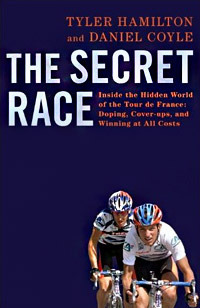
Order the hardcover from Amazon
Order the Kindle Edition
I’ve been reading Tyler Hamilton’s new book, The Secret Race: Inside the Hidden World of the Tour de France: Doping, Cover-ups, and Winning at All Costs, co-authored by Daniel Coyle, a journalist and author with considerable literary talent. It’s a gripping story about how Tyler Hamilton, Lance Armstrong, and all the other top cyclists have been doping for decades, using such advanced scientific programs of performance enhancement that estimates show the benefit could be as much as 10%, in races won by tiny fractions of 1%. After nearly two decades of doping and trying it without dope, Hamilton explains that although a clean rider might be able to win a one-day race, it is not possible to compete in, much less win, a 3-week event like the Tour de France.
The lengths these guys go to win are almost beyond comprehension. All you do is train, eat, and sleep. And dope. The drug of choice is (or was, now that the drug testers have caught up—riders use other drugs that have similar effects) EPO, or erythropoietin, a genetically modified hormone invented by Amgen that stimulates the body to produce more red blood cells, a life-saver for anemic patients undergoing chemo or suffering from other long-term ailments. Also on the menu is testosterone, human growth hormone, steroids (for injuries, not bulk, since cyclists get as skinny as they can), and others. Tyler nicknamed his EPO Edgar, as in Allen Poe. The drugs worked, he says, but only if you do everything else necessary, including logging in 5–6 hour daily training rides, get your body fat down to 5% or less, and program your entire life to doing nothing but racing bikes. If you are not riding, rest. Don’t walk when you can sit. Don’t sit when you can lie down. And don’t ever climb stairs. You are either a bike rider or a couch potato. If you are genetically gifted, train your ass off, starve yourself down to a skeletal frame with bird-like arms and Schwarzenegger-size legs, can ride as fast as the wind, and get on a professional team invited to the Tour de France, then and only then will the drugs give you the edge to boost yourself from barely finishing stages to contending for a top finishing spot. Hamilton estimates that the dope is worth somewhere between 50 and 100 places in the Tour de France. Yes, you might survive the race on “pan y agua” (bread and water—the riders’ euphemism for non-doping programs), but if you want to feel better than death you have to take the drugs.
Okay, so everyone does it and the playing field is level, right? Wrong. First, there’s a serious science behind proper doping, and if you don’t have the dough to hire the best dope—and doping doctors—you’re left fumbling around with dosages and frequencies and wondering if the needle or bag of blood is contaminated with Hep-C, or if you screwed up, overdosed, and are still “glowing” when the drug tester pops in for an out-of-competition surprise drug test. The top pros pass hundreds of drug tests because they had the top doping docs to show them how to do it properly. So maybe the top 25% of the peloton are doping professionally. Another 50% or so are doping unprofessionally. The rest are riding pan y agua. And suffering beyond belief. Not a level playing field.
But the real harm is to those athletes who did not want to dope, who were given the choice to dope and opted out, who pulled over to the curb on the boulevard of broken dreams, stripped off their race number, and packed it in to go home, in most cases back to menial jobs or to finish high school or start college. Who are these cyclists? Tyler names a few in his book, but in most cases we have no idea who they are because they are the unseen ones. Those whose potential was never realized because they never had the chance to compete cleanly against their peers. We’ll never know how they might have done against the very best in the business because the best cheated to get there. Could Cyclist Joe from Hannibal, MO beat Lance Armstrong from Austin, TX? We’ll never know. Cyclist Joe is now Joe the Plumber, Mr. Everyman, while Lance is still glowing.
What is seen are the champions and the cheaters. What is unseen are the honest ones who had the courage and the character to walk away with their morality. This is the larger lesson of cheating. It robs everyone of what might have been. With cheating, what might have been is now what never was. It erases history. What is prologue is past.
September 1, 2012
Conspiracy Contradictions
are prone to believe others

ON WEDNESDAY, MAY 16, I spent several hours on a hot bus in a neon desert called Las Vegas with a merry band of British conspiracists during their journey around the Southwest in search of UFOs, aliens, Area 51 and government cover-ups, all for a BBC documentary. One woman regaled me with a tale about orange balls of energy hovering around her car on Interstate 405 in California, which were subsequently chased away by black ops helicopters. A man challenged me to explain the source of a green laser beam that followed him around the English countryside one evening.
Conspiracies are a perennial favorite for television producers because there is always a receptive audience. A recent Canadian Broadcasting Corporation documentary that I participated in called Conspiracy Rising, for example, featured theories behind the deaths of JFK and Princess Diana, UFOs, Area 51 and 9/11, as if there were a common thread running throughout. According to radio host and conspiracy monger Alex Jones, also appearing in the film, “The military-industrial complex killed John F. Kennedy” and “I can prove that there’s a private banking cartel setting up a world government because they admit they are” and “No matter how you look at 9/11 there was no Islamic terrorist connection—the hijackers were clearly U.S. government assets who were set up as patsies like Lee Harvey Oswald.”
Such examples, along with others in my years on the conspiracy beat, are emblematic of a trend I have detected that people who believe in one such theory tend to believe in many other equally improbable and often contradictory cabals. This observation has recently been confirmed empirically by University of Kent psychologists Michael J. Wood, Karen M. Douglas and Robbie M. Sutton in a paper entitled “Dead and Alive: Beliefs in Contradictory Conspiracy Theories,” published in the journal Social Psychological and Personality Science this past January. The authors begin by defining a conspiracy theory as “a proposed plot by powerful people or organizations working together in secret to accomplish some (usually sinister) goal” that is “notoriously resistant to falsification … with new layers of conspiracy being added to rationalize each new piece of disconfirming evidence.” Once you believe that “one massive, sinister conspiracy could be successfully executed in near-perfect secrecy, [it] suggests that many such plots are possible.” With this cabalistic paradigm in place, conspiracies can become “the default explanation for any given event—a unitary, closed-off worldview in which beliefs come together in a mutually supportive network known as a monological belief system.”
This monological belief system explains the significant correlations between different conspiracy theories in the study. For example, “a belief that a rogue cell of MI6 was responsible for [Princess] Diana’s death was correlated with belief in theories that HIV was created in a laboratory … that the moon landing was a hoax … and that governments are covering up the existence of aliens.” The effect continues even when the conspiracies contradict one another: the more participants believed that Diana faked her own death, the more they believed that she was murdered.
The authors suggest there is a higher-order process at work that they call global coherence that overrules local contradictions: “Someone who believes in a significant number of conspiracy theories would naturally begin to see authorities as fundamentally deceptive, and new conspiracy theories would seem more plausible in light of that belief.” Moreover, “conspiracy advocates’ distrust of official narratives may be so strong that many alternative theories are simultaneously endorsed in spite of any contradictions between them.” Thus, they assert, “the more that participants believe that a person at the centre of a death-related conspiracy theory, such as Princess Diana or Osama [bin] Laden, is still alive, the more they also tend to believe that the same person was killed, so long as the alleged manner of death involves deception by officcialdom.”
As Alex Jones proclaimed in Conspiracy Rising: “No one is safe, do you understand that? Pure evil is running wild everywhere at the highest levels.”
On his Infowars.com website, Jones headlines his page with “Because There Is a War on for Your Mind.” True enough, which is why science and reason must always prevail over fear and irrationality, and conspiracy mongering tra”cs in the latter at the expense of the former.
August 28, 2012
Mystery UFO Photo
I thought I would share with you an email and photographs submitted to me by a gentleman named Marc Richard. Instead of telling you what I think it is, I’d like to hear from you what you think is the best explanation. Submit your best guess in the comments section below.
Hello, I’m not sure where to send these, or if your even looking for this kind of thing, couldn’t find a submissions page on the site. I have eight photos, I’ll send you two, if your interested I’d be happy to send the rest. Here’s what I wrote about the photos at the time I took them:
“On Oct, 19, 2009 at around 6:30pm, I was working on the 18th floor of my apartment building in downtown Detroit, when I noticed something floating around the two smoke stacks on the power plant near my place. It seemed to be hovering directly through the smoke of the stacks, and then around the two stacks, in between the two stacks, and then it would float a few blocks away and then back to the stacks. At this point I had been watching this thing for about 8 minutes or so when I ran to grab my camera and returned with my girlfriend and my brother in law. So I snapped off these pics which I can’t explain. It seems to be pretty small (about the size of one of those little smart cars?) I sent these photos to UFOs Northwest shortly after taking them. They’re still up on that site, nobody seems to have an explanation for them. If you have any questions I’d be happy to try and answer them.”
I know your busy and don’t want to waste your time, it’s just that I’ve lived down here a long time and I’ve watched plastic bags/ balloons float around in the updrafts of buildings a hundred times. Look at the side profile of this thing, I don’t think it’s a sphere as much as a strange diamond cut geometry. This thing would hold its altitude precisely and float off three or four full city blocks away and then return to the stacks, and never even waver slightly in its flight. And then through the actual smoke leaving the stack without changing altitude. I really do appreciate your opinion on this matter so thanks once more for taking the time.
Sincerely, Marc Richard
Click the photos to enlarge them and then leave your comment below.






August 21, 2012
The Muddle of Truth
Travis Walton responds to Michael Shermer
EDITOR’S NOTE: This article by Travis Walton explains his side of what happened on this dreadful Fox television show on which I also appeared and described in last week’s Skepticblog. To understand Walton’s explanation you should read that article first, but if you don’t have time the upshot of the story is that Travis Walton claims that on November 5, 1975 he was abducted into a UFO in an Arizona national forest during a logging job and that his co-workers witnessed the event. According to the late UFO investigator Philip Klass, Walton passed one polygraph test (published) but failed another (unpublished), and in his opinion Walton and his associates made up the story as an excuse for failing to complete the logging job on time. Walton’s side of the story is recounted in detail in his 1978 book The Walton Experience, later reissued as Fire in the Sky, the title of the 1993 film based on the book. —Michael Shermer
With the recent airing overseas of the canceled Fox television show, Moment of Truth some people may have been mislead into believing that some shocking new revelation about the famous logging crew UFO case has come to light. Quite the contrary. Now that the airing of the show ends the “gag clause” in my contract (with its $1 million penalty) I am free to reveal that Moment of Truth has used testing methods that the producers were informed from the beginning were long ago completely discredited by every polygraph expert, lie detector school, and polygraph professional association in existence. I’ll quote here specific condemnations of the show’s methods by four of the world’s most highly respected polygraph experts who agree: “the polygraph aspect of the show has no validity whatsoever.” I will reveal other blatant deceptions the show has committed. And I will provide details of how, after the show, I underwent two of the most rigorous new polygraph tests available anywhere in the world.
I should have seen it coming. I should have known better. But there were unique circumstances. The company where I had worked for almost a decade announced a corporate headquarters decision to downsize by permanently terminating the 50 most recently hired workers, regardless of their performance. My hire date put me on that list. I came home that day to receive a phone call inviting me to be a “contestant” on a show I’d never seen that offered the possibility of winning up to $100,000. An opportunity to solve my layoff problem? I was wary. I began taping our negotiations. I watched an episode. I knew the examiner was their man, with every incentive to keep his employers from having to pay out big prize money. I wrote emails to a few of my friends about my apprehensions. I wrestled with doubt. I learned the show specialized in setting “contestants” up for dramatically devastating revelations (a la Jerry Springer). Still, it appeared I was on the brink of financial problems and all I had to do was answer 25 questions truthfully. What could be easier than that?
Impossible, I later learned. In all the show’s years almost no contestants had ever won the top prize. But I didn’t know that yet, so I asked, does the examiner use modern accepted methodology? I was assured he did. This was a lie—as far from true as you can get. The producer telling me this untruth may have believed it simply because the higher ups said so. Or they all—producers and network—may have been deceived by the examiner, who, with his training absolutely had to know his methods were bogus. We went back and forth. I sent them my refusal. They came back and were very persuasive and said they were planning on responding to criticisms by making sure more prizes would be awarded. I so very foolishly yielded to the temptation. Even after arriving for taping I learned such disappointing details and got such bad vibes that I announced I was going home. But my objections were negotiated away. I found out a major portion of episodes already taped never aired because the “contestants” withdrew and walked out.
By then I felt trapped into something I suspected was rigged from the ground up. My confidence in the examiner (essential for proper testing) was destroyed when he lied to me. He said he knew Arizona Department of Public Safety polygraph examiner Cy Gilson, who previously tested the woods crew, and was using the same method and equipment he did. His ancient polygraph machine was obviously not the state of the art computer-assisted equipment Cy Gilson uses. The final nail was learning that he only goes through the questions once! What?! Item #5 of the American Polygraph Association’s Standards and Principles of Practice that I quoted in my 1996 book Fire in the Sky (which I had loaned the producer) specifically prohibits rendering an examiner’s conclusion on the basis of a single run of the list. Modern method requires three separate runs through the same identical list of questions, sometimes four. Without these comparison charts there is no way to discern deception from random fluctuations in the subject’s responses. For example, even though crewman Allen Dalis “basically told the truth” according to the sheriff’s files in his first test with Cy Gilson, he was given an “inconclusive” just because he only did the list twice, storming out before the third run. (Allen passed a second test with Gilson in 1993 with flying colors). And modern methods limit relevant questions to three or four per test. The show’s rogue examiner was doing over 50 questions! Even more damning, the examiner had the option to pick the 25 questions to be used in the show, further removing objective comparison.
Earlier, a fake segment pretending to be my test was filmed with an actor in place of the examiner while my arm with the sensors attached rested comfortably on a table as per proper procedure. Later their actual “test” required me to hold my arm perfectly still while balancing it on a narrow one inch wide steel chair arm for the entire 50+ questions, a very long time, and excruciating. This was guaranteed to cause random stress reactions in their “contestants,” totally unrelated to deception. And, of course, with no comparison charts, there could be no way to see if this “reaction” was repeated all three times at the same question. Also, the test was done, as per examiner’s instructions, with my shoes removed, with my eyes closed, with a panel of at least six strangers staring at me. This sort of distraction was never part of any test I had ever heard of. Every test I know of consisted of the examiner and the subject alone in a room without interruptions.
When the “false” verdict (to the question “Were you abducted into a UFO on November 5, 1975?”) was announced the audience started booing. The host, Mark L. Walberg, turned to them and asked, “How many still believe he is telling the truth?” The audience erupted in cheering, long and loud. He asked how many now disbelieved and got only a few scattered calls from the back. They cut this out. Not long after the show I wrote one of the show staff and said, “They could edit that out or cut the volume…but that would be deceptive, wouldn’t it?” My prediction was right. They also rearranged the reaction shots of my family, even re-using some, moving them from after the verdict to before, creating another false perception.
By the way, not only was I judged truthful on other questions consistent with the reality of my incident, but fellow crewman Ken Petersen was also on the show and was paid a prize for passing his test question about witnessing the incident. So of course that too was deceptively edited out.
The United States GAO (Government Accounting Office) discovered that the method upon which Moment of Truth based their method (and further degraded) yielded up to 80% false positives (truth tellers judged to be liars). This method is illegal in some states to the point of revoking the license of anyone using it. The Moment of Truth examiner, in fact, regularly committed most of the 13 Activities of Unethical Examiners listed on the American Association of Police Polygraph Examiners website.
Cleve Backster is one of the pioneers in polygraph research and development, and is recognized as one of the top experts in the field. Techniques currently widely used in polygraph bear his name. He has administered hundreds of polygraph training courses and advanced seminars to law enforcement personnel at the municipal, state, and federal levels. Backster has been an interrogation instructor for the U.S. Army Counterintelligence Corps, an interrogation specialist with the CIA and has been a guest instructor at Fort Gordon, the U.S. Department of Defense Polygraph School, the Canadian Police College Polygraph Examiner School, and the FBI Academy. He has held numerous high ranking posts in polygraph professional associations, and has testified as an expert witness before the U.S. Congress in 1964 and 1974. Backster Associates said, “Moment of Truth uses a technique in polygraph that was discarded years ago.”
Arizona State Police polygraph examiner Cy Gilson, who tested the entire woods crew, said, “there can be no validity to the test results in such a procedure. The pseudo examiner is a whore and the show’s producer is the pimp.”
Dr. David Raskin has authored hundreds of scientific papers on polygraph. As a court recognized expert he has testified in cases such as the Howard Hughes will, Jeffrey (Fatal Vision) McDonald, serial killer Ted Bundy, the DeLorean affair, and the McMartin preschool case. Raskin has testified before British Parliament, the Israeli Kineset, and four times before the Judiciary Committee of the U.S. Senate with regard to Watergate and Iran/Contra. Dr. David Raskin said, “I have always thought those programs are a disgrace. They trick people into participating and then use unprofessional and inaccurate methods merely for the purpose of entertaining their audiences. Any polygraph examiner who participates in such charades should not be allowed to practice. I have been asked to be the principal in such shows and have always refused. It is unfortunate that they lured you into being abused by them. I agree with the criticisms by Mr. Martin.”
R. Michael Martin, President of Global Polygraph Network and court certified polygraph expert, created a website, The Truth About the Moment of Truth when the show first aired (and of course long before my show) in the U.S. He writes: “FOX TV has intentionally blocked us from publishing this information on their public internet forum….” His site gives reasons: “the polygraph aspect of the show has no validity whatsoever.” “This test format will not determine truth or deception.” And in conclusion, “Due to the vague, subjective, futuristic nature, and sheer volume, of relevant questions asked on The Moment of Truth, there can be little more than chance accuracy in determining truth or deception to these questions. In other words, they could simply flip a coin and achieve the same accuracy levels.”
I came home after Moment of Truth and sought out the most rigorous new testing I could find. Polygraph evidence is admissible in court in New Mexico and so is tightly regulated by state law. I chose the firm with the highest recommendations, one that does work for the New Mexico State Prison, the Albuquerque Police Dept., even the United States Marshal’s Service. They applied the most refined and validated modern methods using state-of-the-art computer assisted, five trace equipment with digital readout. I passed two separate tests flawlessly with “a finding of: TRUTHFUL TO THE ABOVE RELEVANT QUESTIONS.” (Additional details in my updated edition of Fire in the Sky.)
To a rational person there could be no doubt that my passing five tests from three separate examiners, each of whom have strong service in law enforcement, completely eclipses the phony pretend “test” by the rogue examiner scamming the public on Moment of Truth. I challenge skeptics to find a single legitimate polygraph examiner who will publicly stand by the methods used there. Nevertheless, bafflingly, there will be people who do some dumb thing like try to pretend that contending verdicts make it all too confusing, so we should just throw it all out and consider the case unsupported by anything. A sneaky kind of intellectual dishonesty that really means they are going against the recognized experts and essentially accepting the claim by the discredited polygraph operator. To a skeptic a failed verdict, even from the worst operators, is eagerly embraced, while passed verdicts, regardless of superior credentials, just has to be doubted.
Sigh, it never ends.
August 14, 2012
Travis Walton’s Alien Abduction Lie Detection Test
UFO abduction case in history
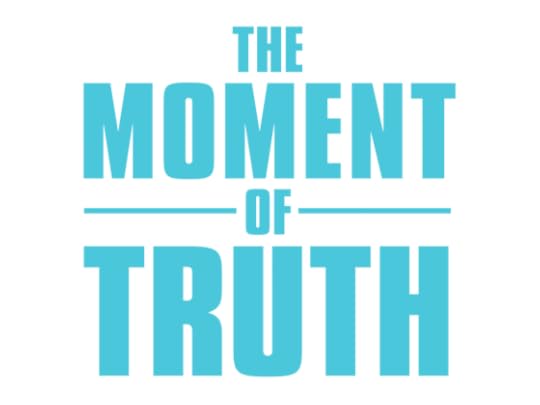
Because I have a teenage daughter I am relatively current on what’s popular in pop culture. American Idol is the ne plus ultra in the reality television genre (don’t let yourself get hooked), and because Fox incestuously promotes its other shows I was vaguely familiar with The Moment of Truth, a game show in which contestants have to tell the truth under the watchful wires of a lie detector in order to win cash prizes. Contestants are put through a battery of questions while hooked up to the polygraph, but are not told whether the examiner determined from the readings whether or not they told the truth. Later, in front of millions of viewers and a live studio audience, with their friends, co-workers, family, spouses, or boyfriends and girlfriends (or ex’s) sitting on the set with them, they are asked the same questions again. After each answer a female voice says “That answer is…” and after a long pause a “true” means the contestant continues up the ladder to $25,000, $100,000, $200,000 all the way to half a million bucks. A “false” sends you packing for home.
One night a woman was faced with her husband and ex-boyfriend and was asked if she wished she had married the other guy. “Yes,” she said. “That answer is…true,” sounded the voice. She won the money but lost the husband. I remember thinking to myself, “you’d have to be a real pinhead to go on this show.”
On July 31, 2008, I appeared on The Moment of Truth (watch Part 1 on YouTube. I appear at about 7 min. 35 secs. in Part 2.) The contestant was Travis Walton, arguably the most famous alien abductee in Earth history. I agreed to appear only if there were no sexual allusions (alien probes aside). My question for Mr. Walton: “Do you have any evidence to support your claim of being abducted?” Of course he answered in the affirmative, because for three decades Travis Walton has been telling people that on the evening of November 5, 1975, he was “zapped” into a UFO while working as a logger in an Arizona National Forest. His evidence? His co-workers said they saw it happen. Five days later Walton called from a nearby payphone to report that the aliens had let him go.
And none too soon, because Walton and his co-workers were about to miss their deadline of November 10th to finish the logging job, after which they would be docked 10 percent of the contract, unless an “Act of God” prevented completion. Enter the UFO. Why aliens? For years Travis and his older brother Duane had talked about the UFOs that they had seen in Arizona, and they even made a pact that if either one were ever abducted they would insist that the aliens abduct the other one as well. Coincidentally (not!), two weeks before Walton’s abduction, with the logging deadline growing near, NBC aired their prime-time made-for-television movie The UFO Incident, about the 1961 Betty and Barney Hill abduction case.
In the considered opinion of the late aviation journalist Philip Klass, in his 1988 book UFO-Abductions (Prometheus Books), Walton and his buddies just made up the story as an excuse to account for their pending job incompletion. In his investigation of the case, Klass discovered that during the five days that Walton was missing none of his family or co-workers showed any concern whatsoever for his safety during several interviews by media and interrogations by law enforcement agents. His brother Duane confessed: “He’s not even missing. He knows where he’s at, and I know where he’s at.”
Although Walton passed a polygraph test arranged by a UFO organization, Klass learned that Walton dictated to the examiner what questions would be asked. Further investigation by Klass led him to an earlier unpublished polygraph test of Walton, conducted by Jack McCarthy, one of the top polygraph examiners in Arizona. McCarthy gave Klass his assessment of Walton’s story: “Gross deception!” He added that Walton employed polygraph countermeasures, such as holding his breath.
Now, 33 years later, Walton was once again in the polygraph hot seat. His affirmative answer to my question passed the truth test, because of course Walton believes he has evidence in the form of his friends’ corroborative story. The next question, for $100,000, was refreshingly straight-forward: “Were you abducted by a UFO on November 5, 1975.” Without hesitation he barked “Yes.” The voice in the sky once again boomed: “That answer is…”
“False.” I couldn’t believe it. Neither could Walton, whose jaw dropped faster than a crashed flying saucer. At last, after a bestselling book and popular film about his abduction, Fire in the Sky, after countless UFO conferences and media appearances, it took a Fox reality television show to bring the case to a head. What does this mean? To be fair and balanced (!), possibly nothing, because the polygraph test is unreliable. In fact, I even thoroughly debunked it myself in a two-part special for the Fox Family channel (watch Part 1 and Part 2 on YouTube).
Given the shortcomings of both reality television and the polygraph, I wrote to Travis and asked him for his account of his experience on Moment of Truth. I had met Walton once before at my office in Altadena, California, where we filmed a segment for a television special on UFOs. I found him to be an exceptionally likeable man, a nice guy, and I found his account of this television show to be most illuminating. As he wrote me on August 21, 2009:
I normally would not have ever agreed to be on such a show. After my fellow crewmen and I passed polygraph tests from the Arizona state police polygraph examiner I wrote in my book that I was done addressing that aspect of it. There the matter rested until last year when I received the bad news from my employer of 11 years that over a hundred of those most recently hired (which included me) would be permanently laid off. Coincidentally I came home that day to receive a phone call from The Moment of Truth inviting me to be a contestant with the possibility of winning up to $100,000.
I’m no fool. I knew that the show’s public lure was to familiarize the audience with the contestant’s friends& family and then shockingly disgrace him with a key “failed” question. I wrote to several friends about my misgivings. The examiner was their man, with a vested interest in giving his employer the scandalous Jerry Springer type “entertainment” that has been the show’s stock in trade — to say nothing of saving them from awarding any prize money. I was made even more uneasy to learn that up to then very few had won much of anything. The outrageous demands set down in their contract was the clincher. I declined their offer.
But they persisted, modifying the standard contract to satisfy my objections. They said the rules were being changed to insure more prizes would be awarded. My looming layoff pushed me to reconsider. I inquired as to whether good, accepted modern polygraph methods were being used. They assured me that was the case. I should have known better, but I figured all I had to do was tell the truth, even if I had to make public something embarrassing like a personal business or marital mistake and I would win top prize.
I didn’t became aware of the shocking truth about the polygraph procedure they were using until it was too late. It did no good to tell them what I’d written in my book (page 322) years earlier, that “The American Polygraph Association’s Standards and Principles of Practice item #5 states: “A member shall not provide a conclusive decision or report based on chart analysis without having collected at least two (2) separate charts in which each relevant question is asked on each chart. A chart is one presentation of the question list.” There many other violations of accepted procedure.
We came back home and my wife had me retested with the most rigorous new tests we could find — in New Mexico where it is stringently regulated by the state because results are admissible in court there. A firm highly recommended by other examiners, one that does work for the Albuquerque Police Dept, the NM State Prison, and the U.S. Marshal’s office. The most accepted methods on state-of-the-art computerized equipment. I passed two different new tests flawlessly. Then I found a website that was even more devastating of any claim of legitimacy for The Moment of Truth: The Truth About the Moment of Truth. Written by a court certified polygraph expert back in 2004 shortly after the show debuted, he began with, “…the polygraph aspect of the show has no validity whatsoever.” and “This test format will NOT determine truth or deception.” In fact I wrote years ago that the GAO tests showed such methods would yield as high as 80% false positives. He wrote in conclusion, “Due to the vague, subjective, futuristic nature, and sheer volume, of relevant questions asked on The Moment of Truth, there can be little more than chance accuracy in determining truth or deception to these questions. In other words, they could simply flip a coin and achieve the same accuracy levels.”, saying you’ll get the same opinion from any accredited polygraph school. I then proceeded to gather several more equally damning judgments from some of the very top experts in the world in polygraph, plus I had several international mediaforums lined up. So there’s a bit of a let down because I was geared up to defend myself in a way that would have unfortunately demolished the show and seriously hurt Fox. Too bad, because I think that the producers I dealt with are good, well intentioned people who had been duped by a dishonest examiner.
Check out that website and tell me what you think.
I think the polygraph is not a reliable determiner of truth. I think Travis Walton was not abducted by aliens. In both cases, the power of deception and self-deception is all we need to understand what really happened in 1975 and after.
August 1, 2012
Free Won’t

AT A RESTAURANT RECENTLY I faced many temptations: a heavy stout beer, a buttery escargot appetizer, a marbled steak, cheesecake. The neural networks in my brain that have evolved to produce the emotion of hunger for sweet and fatty foods, which in our ancestral environment were both rare and sustaining, were firing away to get me to make those selections. In competition were signals from other neural networks that have evolved to make me care about my future health, in particular how I view my body image for status among males and appeal to females and how sluggish I feel after a rich meal and the amount of exercise I will need to counter it. In the end, I ordered a light beer, salmon and a salad with vinaigrette dressing and split a mildly rich chocolate cake with my companion.
Was I free to make these choices? According to neuroscientist Sam Harris in his luminous new book Free Will (Free Press, 2012), I was not. “Free will is an illusion,” Harris writes. “Our wills are simply not of our own making.” Every step in the causal chain above is fully determined by forces and conditions not of my choosing, from my evolved taste preferences to my learned social status concerns—causal pathways laid down by my ancestors and parents, culture and society, peer groups and friends, mentors and teachers, and historical contingencies going all the way back to my birth and before.
Neuroscience supports this belief. The late physiologist Benjamin Libet noted in EEG readings of subjects engaged in a task requiring them to press a button when they felt like it that half a second before the decision was consciously made the brain’s motor cortex lit up. Research has extended the time between subcortical brain activation and conscious awareness to a full seven to 10 seconds. A new study found activity in a tiny clump of 256 neurons that enabled scientists to predict with 80 percent accuracy which choice a subject would make before the person himself knew. Very likely, just before I became consciously aware of my menu selections, part of my brain had already made those choices. “Thoughts and intentions emerge from background causes of which we are unaware and over which we exert no conscious control,” Harris concludes. “We do not have the freedom we think we have.”
True enough. But if we define free will as the power to do otherwise, the choice to veto one impulse over another is free won’t. Free won’t is veto power over innumerable neural impulses tempting us to act in one way, such that our decision to act in another way is a real choice. I could have had the steak—and I have—but by engaging in certain self-control techniques that remind me of other competing impulses, I vetoed one set of selections for another.
Support for this hypothesis may be found in a 2007 study in the Journal of Neuroscience by neuroscientists Marcel Brass and Patrick Haggard, who employed a task similar to that used by Libet but in which subjects could veto their initial decision to press a button at the last moment. The scientists discovered a specific brain area called the left dorsal frontomedial cortex that becomes activated during such intentional inhibitions of an action: “Our results suggest that the human brain network for intentional action includes a control structure for self-initiated inhibition or withholding of intended actions.” That’s free won’t.
In addition, a system has “degrees of freedom,” or a range of options that may result from its complexity and the number of intervening variables. Ants have a few degrees, rats more, chimps many more still, humans the most. Some people—psychopaths, the brain-damaged, the severely depressed or the chemically addicted—have fewer degrees than others, and the law adjusts for their lowered capacity for legal and moral accountability.
These vetoing neural impulses within a complex system with many degrees of freedom are part of the deterministic universe. Thinking of volition as a component of the causal net lets us restore personal responsibility to its rightful place in a civil society.
July 31, 2012
The Colorado Massacre, Gun Control, and the Law of Large Numbers
It is too soon to tell what the motive was behind the accused James Holmes’ mass murder in a movie theater in Aurora, Colorado, especially now that he has stopped talking to the authorities in charge of his case. Reports about his personality, thoughts, and behaviors from friends, fellow students, professors, and the police are conflicting. He was smart, brilliant in fact. No, he wasn’t; he was a sub-standard student who dropped out of his doctoral program at the University of Colorado after failing a preliminary exam. He was a quiet man who said nothing to indicate he was on the verge of cracking. Also not true; he left an incoherent and rambling voice message on the phone service of a gun club he wanted to join, the owner of which noted: “It was this deep, guttural voice, rambling something incoherent. I thought, ‘What is this idiot trying to be?’.” He rigged his apartment with explosive devices but then warned the police about them after his capture. Initial reports described the event as spontaneous and random, but he mailed a notebook to his psychiatrist at his university describing in detail with diagrams precisely what he (pre)planned to do.
It may be months before we have any clue to his mind and motive. And short of something obvious like a brain tumor pressing against his amygdala (the brain’s emotion center)—similar to that in the brain of Charles Whitman, the University of Texas bell tower shooter who in 1966 killed 49 people including himself after leaving a note to authorities to autopsy his brain because he felt there was something wrong—we may never know the motive behind James Holmes murderous actions.
We do know something for certain, however, and that is that this will happen again…and again and again. The reason is the law of large numbers that I will outline below that are disturbing enough that it really is now time to rethink our gun-control laws to include the prohibition of semi-automatic assault rifles like those Holmes’ allegedly used to murder 12 and wound another 58 in a matter of seconds. Had he not had such weapons—possessing, say, only a pistol purchased for self-defense—the tragedy would surely have been lessened. Thus, even though I am a life-long libertarian who champions freedom in all spheres of life and has previously opposed gun-control measures in principle (I do not personally enjoy hunting or recreational gun shooting), I now believe that the freedom of a few people to own WMMs (Weapons of Mass Murder) conflicts with the freedom of the rest of us to enter the public sphere without the chance of our ultimate freedom of life itself being cut short. Here are a few figures that should give even the most freedom-loving libertarian and conservative pause.
First, there’s a good chance that James Holmes is schizophrenic, suffered from severe depression, or is a psychopath. According to the National Institute of Mental Health, Schizophrenics account for about 1.1 percent of the U.S. population over the age of 18, with the onset of occurrence most likely in the early to mid 20s. Major depressive disorders strike about 6.7 percent of Americans over the age of 18. Psychopathy is a personality disorder characterized by lacking empathy and guilt, shallow emotions and cold-heartedness, impulsivity and antisocial behaviors, and most notably criminality. According to University of Cambridge psychologist Kevin Dutton, author of the forthcoming book The Wisdom of Psychopaths: What Saints, Spies, and Serial Killers Can Teach Us About Success (Farrar, Straus and Giroux, October 16, 2012), whom I queried for this article, “estimates of the incidence of psychopathy tend to vary from 1–3 percent in men to 0.5–1 percent in women,” and in prison populations “around 50 percent of the most serious crimes on record—crimes such as murder and serial rape, for instance—are committed by psychopaths.”
As a back-of-the-envelope calculation, let us employ a figure of 2 percent across these three disorders (Schizophrenia, major depression, and psychopathy) for men only (since such mass murders are almost always committed by men)—by the law of large numbers the following calculations indicate that the Aurora tragedy is by no means a one-off event and that it will happen again:
The current U.S. population is approximately 314 million, about half of which are males, so if 2% of the 157 million American men suffer from one of these severe disorders, this results in a figure of 3,140,000. Most of these men are not violent; in fact, recent studies on psychopathy, for example, show that many are successful CEOs, politicians, and Wall Street traders and executives who employ their psychopathic personality traits of tough-minded and emotionless impulsive decision making to great effect in the rough-and-tumble world of business and politics. And most Schizophrenics and sufferers of severe depression are not violent. So let’s conservatively estimate that if only 1% of these 3,140,000 men commit any kind of violent act, this results in 31,400 acts of violence per year, a nontrivial number.
If only 1% of those violent acts involve murders, this leaves us with 314 unnecessary tragic deaths caused by psychopaths. And, finally, if only 1% of those murderous violent acts involves killing multiple people at once, this results in a rate of 3.14 Aurora-size mass murders per year in America, which is actually lower than the rate of around a dozen per year that we have been averaging the past half century, depending on what constitutes a mass murder (school-shootings alone that amount to more than one killed in one event happen on average once a year in the U.S.).
Again, it’s too early to say whether or not Holmes was a Schizophrenic, suffered from severe depression, or was a psychopath, and the specific figures of how many mass murders there are per year vary across different data sets, but my point is a larger one: A large-numbers analysis allows us to understand on a societal-level scale why such events happen randomly and without any specific cause common to all (drugs, gangs, bullying, depression, psychopathy, psychosis, violent video games, and the like). History and population demographics for rates of mass murder show that Aurora-size events are going to happen again and again and again, and there is no way to predict who is going to do it, where, or when. (With the possible exception of a national database that tracks and alerts authorities to the purchase of mass quantities of guns and ammunition by private citizens.) All we know is that it will happen again—for certain.
Thus, damage control is the only option we have, if we want to do something about this tragic social problem. And by damage control I mean gun control. Specifically, I mean outlawing all automatic and semi-automatic assault rifles for anyone who is not in law enforcement or the military. When the Second Amendment was written stating that citizens have a right to “keep and bear arms,” rifles took over a minute to load one bullet at a time. The most crazed 18th century American could not possibly commit mass murder because no WMMs existed at the time.
My fellow libertarians are likely to see this as another loss of freedom, but I disagree. The principle of freedom states that all people are free to think, believe, and act as they choose, so long as they do not infringe on the equal freedom of others. But the freedom for me to swing my arm ends at your nose. The freedom for you to own any gun you like is in conflict with my freedom to interact freely with my fellow citizens in public spaces when so many madmen mingle among us. We should ban assault weapons of all kinds. We already disallow private citizens to own nuclear weapons, missiles, grenade launchers, and the like. WMMs that can be secreted into a movie theater should be categorized among those we can no longer tolerate. This is no loss of freedom. It is, in fact, an increase in freedom—the freedom to move about our living spaces without fear of being gunned down in cold blood.
If you think I am exaggerating, or that my calculations are nothing but mathematical hyperbole, just consider the case of Aurora victim Jessica Ghawi, who was almost gunned down in a shopping mall in Toronto in another public shooting the month before, after which she reflected on her blog: “I was shown how fragile life was on Saturday. I saw the terror on bystanders’ faces. I saw the victims of a senseless crime. I saw lives change. I was reminded that we don’t know when or where our time on Earth will end. When or where we will breathe our last breath.”
July 17, 2012
Leaving Las Vegas … Rich
By “rich” I mean intellectually, of course, because as all skeptics know, the laws of probability are precisely employed by all Las Vegas casinos to insure that if you play long enough the money in your pocket will end up in their coffers. It is not for nothing that it is called Lost Wages.
Actually, there are two ways to win at gambling. You can do it the way I did after the final session at TAM Sunday: play for a brief period of time and quit when you are ahead. I started with $200 at a $5 minimum Blackjack table. For around 20 minutes I bounced around between $150 and $250 in chips artfully stacked in front of me as I pretended to be a big spender. The inevitable losing streak then kicked in and I was suddenly down below $50, then clawed my way back up to $228 when it was time to go, saving myself from the over-confidence bias that would have, in time, left me with nothing but green cloth beneath my empty palms. (The other way to win at gambling in Las Vegas? Be the owner of a casino.)
Wednesday afternoon the Skeptics Society photographer Dave Patton and I made the drive to Vegas after our annual bike ride to Mt. Wilson and subsequent Subway sandwich stop to assuage the guilt to come from eating and drinking too much in Sin City. Wednesday night I dined with Mark Skousen and guests at the world-famous Circo restaurant at Bellagio’s, a joint so pricey that the prices are not even printed on the menu. I got to sit next to John Mackey, CEO of Whole Foods, who just completed his book entitled Conscious Capitalism (due out 12-12-12), in which he wants to rewrite the economic narrative of conservatives who have too long embraced the “greed is good” and “the virtue of selfishness” messages of conservatives and libertarians such as Milton Friedman and Ayn Rand. As he told me (I’m paraphrasing from memory, slightly cloudy from imbibing some very fine red wine), “Entrepreneurs, inventors, and creators don’t go into business just to make money. They go into business because they want to change the world, follow their passions, create something new. The money is nice but it isn’t the most important thing.” Conscious capitalism puts people and community and jobs and quality products and service first, money second. Mackey believes what he preaches, carefully selecting from the Circo menu a vegetarian dinner with only the healthiest ingredients, and he tries to do that in his grocery stores. Yes, eating super healthy can cost more, and in some cases some skepticism is appropriate as to whether or not those more expensive foods really make you healthier or not. (I went Vegan once—it started just after breakfast one day and ended at dinner that night.)
John Mackey is an interesting contrast with Steve Jobs, a comparison I made at a Friday panel discussion at Freedom Fest on the late Apple CEO. I noted my concern that the popularity of Walter Isaacson’s biography of Jobs is an example of a selection bias in publishing: no one writes biographies of all the failed Silicon valley entrepreneurs of the 70s, 80s, and 90s. People scour through the personalities and developmental histories of successful entrepreneurs and CEOs in search of the (pick your number) X habits of highly effective leaders (and such). It’s all malarkey. Yes, optimism can be a good trait to have in order to overcome the normal obstacles that one encounters in building an organization or company, but pessimism might make one more realistic when it comes to risk taking, changing directions before it is too late instead of stubbornly pressing on when there is no hope of success. Yes, perhaps being tough minded makes for strong leaders who get more out of their employees by intimidating them or staring at them without blinking (Jobs’s tactic), but tender-minded leaders can also motivate employees through empathy and caring about their welfare. Open-mindedness is good because you are more likely to see the value of new ideas, but if you are too open-minded your brains might fall out and you’ll believe every wacky (and wrong) idea that comes your way. And so forth. You get the idea. There are lots of ways to be successful. Steve Jobs and John Mackey have (near as I can tell) radically different personalities, and yet both were and are successful entrepreneurs and CEOs.
I also sat on a panel with Charles Murray about his new book, Coming Apart, about the state of white America from 1960 to 2010. Murray argues that a cognitive elite has arisen as a result of the fact that our economy is now so dependent on science, technology, and information that requires cognitive skills learned in college and graduate school, and these needed skills under employment have led to a distinct two-culture system of those who live in Fishtown (blue collar) and Belmont (white collar). It’s a good book chockablock full of sociological data, so I focused my attention on his claim that the decline of religiosity and increase in secularism has contributed to the culture divide and the loss of values (so he claims). I disputed that premise that America is losing its religion, given that the polls consistently show that 90% to 95% of Americans believe in God, although I did acknowledge the fact that the fastest growing religious group in America is the “nones”—those who tick the box for “none” when asked by pollsters for their religion.
Murray holds that America’s Founding Fathers, while not especially super religious themselves, believed that religion was necessary for self-governance. That is, if moral controls are not imposed from above by government then they must be imposed from within through religion. Murray believes that the rise of secularism has led to a decline in morals. I asked him what he believes. He said, “I’m a reluctant agnostic who wishes he could believe.” I cited Gregory Pauls’ 2005 study published in the Journal of Religion and Society—“Cross-National Correlations of Quantifiable Societal Health with Popular Religiosity and Secularism in the Prosperous Democracies”—that found an inverse correlation between religiosity (measured by belief in God, biblical literalism, and frequency of prayer and service attendance) and societal health (measured by rates of homicide, suicide, childhood mortality, life expectancy, sexually transmitted diseases, abortion, and teen pregnancy) in 18 developed democracies. “In general, higher rates of belief in and worship of a creator correlate with higher rates of homicide, juvenile and early adult mortality, STD infection rates, teen pregnancy, and abortion in the prosperous democracies,” Paul found. “The United States is almost always the most dysfunctional of the developed democracies, sometimes spectacularly so.” Indeed, the U.S. scores the highest in religiosity and the highest (by far) in homicides, STDs, abortions, and teen pregnancies.
In fact, I sent this study to Murray before Freedom Fest so that he would have time to think about it and provide a thoughtful answer, rather than my trying to ambush him or trip him up. I made the point that I do not believe that religion causes these societal ills, and that in fact I am quite certain that each of them has a different set of causes. Sure homicides have one set of causes different from that of STDs, and the like. But, I noted, if religion is suppose to be such a powerful prophylactic against sin and other societal problems, why is it not working very well here in America, the most religious of all the Western democracies. As well, I pointed out, South American countries are 99% Catholic. All those South Americans accept Jesus as their savior, and yet crime rates are high, poverty is high, etc. By contrast, I concluded, Northern European countries such as Denmark, Sweden, Norway, Germany, etc. have some of the lowest rates of religiosity in the Western world and yet they have exceptionally low rates of homicide, abortion, teen pregnancy, STDs, etc.
Murray’s response surprised me: “Michael, to resolve these issues would best be done over a late night drink and long conversation. But in general my sense about your writings on religion is that you are unnecessarily harsh and unsophisticated and non-subtle in your analysis.” He then explained that even though he’s not a believer his wife is a deeply believing Quaker who takes her religion very seriously, and this impresses him and makes him respect religion.
Interestingly, Charles Darwin felt the same way. He called himself an agnostic (in the sense that his friend Thomas Huxley meant it when he defined the word in 1869 to mean “unknowable”) and noted: “In my most extreme fluctuations I have never been an Atheist in the sense of denying the existence of God. I think that generally (and more and more as I grow older), but not always, that an Agnostic would be the more correct description of my state of mind.” But his wife Emma was a deeply religious woman who bemoaned the fact that if her husband did not believe then they would not spend eternity together. Thus, Darwin avoided the subject when he could. For example, in 1880, Darwin clarified his reasoning to the British socialist Edward Aveling, who solicited Darwin’s endorsement of a group of radical atheists by asking his permission to dedicate a book Aveling edited entitled The Student’s Darwin, a collection of articles discussing the implications of evolutionary theory for religious thought. The book had a militant antireligious flavor that Darwin disdained and he declined the offer, elaborating his reason with his usual flare for quotable maxims: “It appears to me (whether rightly or wrongly) that direct arguments against christianity & theism produce hardly any effect on the public; & freedom of thought is best promoted by the gradual illumination of men’s minds which follow[s] from the advance of science. It has, therefore, been always my object to avoid writing on religion, & I have confined myself to science.” He then appended an additional hint about a personal motive: “I may, however, have been unduly biased by the pain which it would give some members of my family, if I aided in any way direct attacks on religion.” My sense is that Charles Murray is taking a page from the playbook of Charles Darwin in the interests of domestic tranquility and out of love and respect, admirable qualities both.
Nevertheless, I would have liked to get an answer to my question about why the über-religious America has so many societal ills, why über-Catholic South American countries are so socially ill, and why the practically non-religious northern European countries are so socially healthy. Inquiring minds want to know.
I’ll post more later on TAM and Freedom Fest, including an analysis of one of the most magnificent take-downs of a pseudoscientist I’ve ever seen when I arranged to have skeptic Steve Novella debate an anti-vaxxer at Freedom Fest. I’ll also summarize my own debate at Freedom Fest with a Catholic Thomist philosopher on the question: “Is Man a Machine, Animal, or Special Creation?” I think I did about as well as Novella did against the anti-vaxxer, but libertarians are a mixed bag when it comes to religion, with some super skeptical of Big Government but have not an ounce of skepticism when it comes to Big Religion. Likewise when it comes to corporations, which they adore, unless it is Big Pharma in cahoots with Big Government conspiring to make us all sick in the name of Big Profits. (Bill Maher, an anti-vaxxer himself, is the liberal doppelgänger of these libertarians, loving Big Government unless they are in cahoots with Big Pharma, in which case they’re all evil.) Stay tuned…
Michael Shermer's Blog
- Michael Shermer's profile
- 1155 followers


